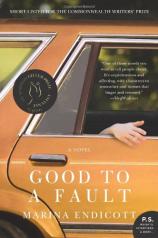Reading Group Guide
Discussion Questions
Good to a Fault

1. “None of the words in church made sense to her. The Creed --- what part of that could she say she believed? Resurrection of the body, life everlasting, not those… She thought of her mother and father falling to shreds in their graves, and then, sharply, of Lorraine.”
Throughout Good to a Fault, there seems to be a tension between faith, or religious sensibility, and the more institutionalized religion of church ritual and scripture. Do you think the novel moves towards reconciliation between the two? How do you think attitudes toward faith and religion have changed in the twenty-first century?
2. Good to a Fault is told from a number of very different points of view. What is the effect of telling the story from a range of perspectives rather than from a single point of view?
3. Aside from a literal collision, what does the collision between Clary’s car and the Dart represent? What differences are immediately apparent between Clary and the Gages?
4. What does Dolly get out of her wanderings throughout the neighborhood? What do books (whether stolen or bought) and reading offer her?
5. As time passes, Clary is alternately “worn out with all this eventful life” and increasingly dedicated to taking care of the Gage children. What is Clary’s motivation in keeping the children? How does that motivation change or develop throughout the book?
6. What is Clary’s initial reaction when Lorraine unexpectedly recovers? Why does Lorraine cut Clary out of the equation so suddenly?
7. Good to a Fault is peppered with quotations from poets --- Gerard Manley Hopkins and Dylan Thomas, in particular, figure prominently. How does their inclusion in the narrative enhance the book?
8. How do you define the concept of home? How has Good to a Fault altered that concept?
Good to a Fault
- Publication Date: March 8, 2011
- Paperback: 400 pages
- Publisher: Harper Perennial
- ISBN-10: 0061825905
- ISBN-13: 9780061825903







